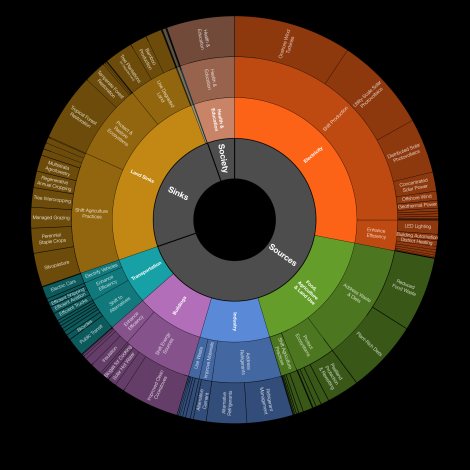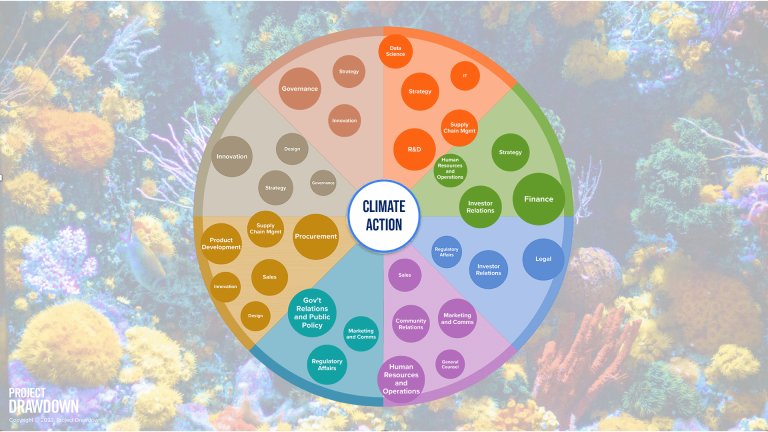It’s difficult to know what matters amid the barrage of voices pitching plans to fight climate change. To simplify, Project Drawdown have reduced the proposals to one criterion: carbon. Well, carbon and the time it takes to reduce it. The reasoning is sound. Increased carbon dioxide in the atmosphere is the principal cause of a changing climate, so each solution should demonstrate the ability to avoid or remove carbon dioxide from the atmosphere.
At the moment, 100 solutions meet Project Drawdown’s criteria. The 501(c)(3) non-profit organization built a Solutions Library that ranks technologies and policies against the metric of gigatons of carbon dioxide reduced or sequestered. Since carbon dioxide is not the only facet of the problem Project Drawdown’s solutions library also estimates costs and earning potential, and reviews each solution based in scientific research.
Now Project Drawdown has released a roadmap showing the path forward to end climate change. The plan has prioritized the actions that matter that we can take right now. It then maps the solutions we should implement in the future.
Dr. John Foley, Executive Director of Project Drawdown, is an award-winning environmental science researcher and professor. Dr. Foley spoke with Engineering for Change about the roadmap, the solutions that will make a difference, and the role that engineering plays in solving the climate crisis. The following is a lightly edited version of the conversation.
Learn more at E4C’s recorded webinar with Drawdown and Autodesk Foundation: Solutions to Reverse Global Warming
E4C: Why a roadmap?
JF: Climate change has been a focus of the science and engineering community for a long time. The world assembled probably the biggest collection of scientists in history for the last 30 years called the IPCC, the Intergovernmental Panel on Climate Change. Tens of thousands of people spent years working on the scientific evidence for climate change, that it’s real, that it’s happening, it’s serious and we know what causes it.
But when it comes to solutions, the science community’s been kind of in the backseat. We’ve had a lot of politicians and activists and business leaders, all with their own agendas, all without much evidence shouting from the rooftops about their personal answers to climate change. So that’s what project drawdown aims to solve.
A few years ago we published a book and then a subsequent library of resources that are saying, ‘here are the viable, real solutions to climate change.’ It’s kind of like a Consumer Reports for climate solutions. So we created what we call now a solutions library that are effective, viable technologically, economically and otherwise. These are the real climate solutions that work.
So that’s the first part of the work, listing the viable climate solutions based on real science, on good economics on good data and empiricism, and presented very transparently.
But a list of solutions isn’t enough to make them real. I can take photographs of food all day long and it doesn’t make me a cook. I need the recipes. I need to know the ‘how.’ The roadmap is the science of ‘how.’ How do we deploy climate solutions? How do we use scientific principles to know what to do, when to do it, where to do it, and how to get the biggest benefits of the process.
Climate change is cumulative
Time is the most important factor, and engineers will love this because it’s a math problem. Climate change is a cumulative problem, it builds up over decades. It’s the integral of all of our pollution over time, the area under the curve. Climate solutions are also an integral, the area under the curve of the cumulative impact of what we do in the future.
So that’s why time is so important. And that’s why early low-tech solutions, things we have right now, are the best ones, because we can start them today. We can start accumulating the impact of these solutions right now. And that’s why there’s a time-value of solutions. The longer we wait, the more we have to discount the effectiveness of the solution.
When we start to do the math correctly, it shows you the futility of investing in faraway kinds of science-fiction solutions like fusion, modular nuclear, carbon removal, things like this, which we keep on talking about, but never seem to arrive. You have to discount those solutions severely because they are at least 20 years away. Probably more. So they’re not going to have lunch time to work.
So the most important variable is time, and it’s just a calculus problem. It’s like, hey, it’s the integral that matters.
Spend on what matters
We have a lot of money going into climate solutions now. Government money, philanthropy, investors, corporations, you know, a lot of money, about (USD) $1 trillion so far, has been spent on climate solutions. But are we putting it in the right places? Well, nobody had a roadmap for that. Now they do. Drawdown mapped exactly where that carbon is.
So, let’s put the money there. We know how much of the problem is in transportation. How much the problem is in buildings, so much of it is electricity or food or heavy industry. So let’s implement those solutions in proportion to the problems. But until now, we didn’t have a guide.
Understand the problem with data
We know who the big emitters are internationally, but what about within a country? Can we use big data, things like satellite information, detailed ground based observations, computer models, to pinpoint more surgically where interventions will make the biggest difference? Like, it turns out that, you know, 75 percent of the greenhouse gases from electricity come from 25 percent of the power plants. So we want to start with those. There are huge methane leaks out of the natural gas infrastructure in a few surgically targeted areas. Let’s start there.
Precision in climate interventions is now possible because we have big data to help guide us to find where the problems are.
Climate change solutions have cascading benefits
Climate Solutions don’t exist in a vacuum. When we solve climate change, we also need to be solving for other things like poverty, inequities and injustice. Really big problems for human wellbeing writ large. So that’s where we’re really stressing that when you think about climate solutions, let’s see if we can multiply, solve and work on other problems at the same time.
For example, what climate solutions can improve human health? That ought to be easy because 9 million people each year die prematurely from air pollution caused by fossil fuels. That’s more than guns, tobacco and warfare combined. It’s the single biggest thing killing people on the planet. So, automatically reducing fossil fuel use is a huge health benefit, especially to vulnerable people who live in the places that are polluted the most.
There are choices to be made about how we deploy climate solutions and ways to do the most good, especially for the most vulnerable.
E4C: How can engineers working in sustainable development use the roadmap?
JF: I think the roadmap will be pretty intuitive to folks in that community because it emphasizes the practical over the glitzy high-tech. It’s asking the question of how do we solve technical problems with an eye towards human problems and things that are pragmatic.
It show how we do this with appropriate technology that actually does the most good. I think it’s very much in the same spirit of what a lot of folks in our community do.
What we’re trying to do is provide a scientific framework for [implementing the solutions we have now]. You know, I could argue all day with a Bill Gates kind of character about the value of high-tech solutions. But draw the curve and tell me how many gigatons [of CO2] you’re going to reduce with a solution that’s not ready until 20 years from now compared to one that’s ready today.
The numbers don’t lie. They’re right there. There are inescapable mathematics that the roadmap shows you. So, I think we’re trying to introduce some scientific rigor to that conversation, some new frameworks and new language, like the time value of carbon or aligning capital and carbon, things like that, that kind of speak to investors and policymakers in ways that they can hear. But also that engineers and scientists can recognize.
We’re trying to bridge the worlds between how scientists would think, and engineers, to decision makers, especially the policy world and investment.
E4C: How many of those people have seen the roadmap?
JF: Well, about half a million people have seen it already, since we launched it. Actually, more than that now. Probably clocking towards a million pretty soon. Most of the audience we’ve been reaching are in business and investing and philanthropy. But we’re also doing a briefing to the White House soon, about how these kinds of tools could be used by governments thinking about their investments and climate solutions.
E4C: Parting words?
JF: Some of the most inspiring leaders in the world to me were people who have some technical know-how and a big heart and are willing to go get their hands dirty. That’s what can change the world. So I really, really applaud folks in this line of work and encourage you all to continue to do great work. Continue to think about how we can pragmatically solve real problems and help real people today. That’s the great work that we need to do more of. So, thanks. A huge thank you to all your members, to the people who do that kind of work.

